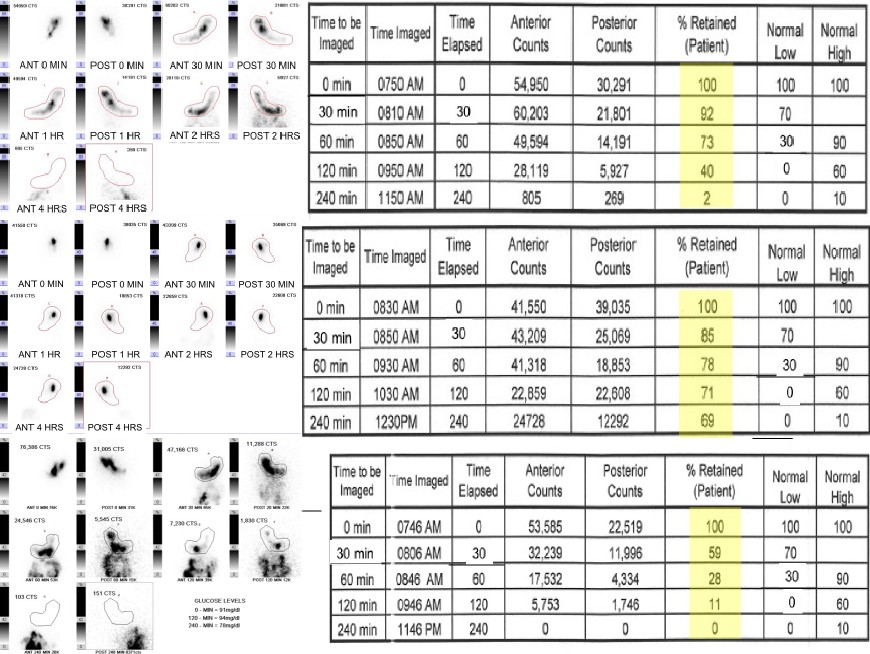[1]
Griffith GH,Owen GM,Kirkman S,Shields R, Measurement of rate of gastric emptying using chromium-51. Lancet (London, England). 1966 Jun 4
[PubMed PMID: 4161213]
[3]
Ziessman HA, Gastrointestinal Transit Assessment: Role of Scintigraphy: Where Are We Now? Where Are We Going? Current treatment options in gastroenterology. 2016 Dec
[PubMed PMID: 27682148]
[4]
Verne GN,Hocking MP,Davis RH,Howard RJ,Sabetai MM,Mathias JR,Schuffler MD,Sninsky CA, Long-term response to subtotal colectomy in colonic inertia. Journal of gastrointestinal surgery : official journal of the Society for Surgery of the Alimentary Tract. 2002 Sep-Oct
[PubMed PMID: 12399064]
[5]
Hejazi RA,Lavenbarg TH,McCallum RW, Spectrum of gastric emptying patterns in adult patients with cyclic vomiting syndrome. Neurogastroenterology and motility : the official journal of the European Gastrointestinal Motility Society. 2010 Dec
[PubMed PMID: 20723071]
[6]
Donohoe KJ,Maurer AH,Ziessman HA,Urbain JL,Royal HD,Martin-Comin J, Procedure guideline for adult solid-meal gastric-emptying study 3.0. Journal of nuclear medicine technology. 2009 Sep
[PubMed PMID: 19692450]
[7]
Calbet JA,MacLean DA, Role of caloric content on gastric emptying in humans. The Journal of physiology. 1997 Jan 15
[PubMed PMID: 9032702]
[8]
Christian PE,Moore JG,Sorenson JA,Coleman RE,Weich DM, Effects of meal size and correction technique on gastric emptying time: studies with two tracers and opposed detectors. Journal of nuclear medicine : official publication, Society of Nuclear Medicine. 1980 Sep
[PubMed PMID: 7411222]
[9]
Hunt JN,Stubbs DF, The volume and energy content of meals as determinants of gastric emptying. The Journal of physiology. 1975 Feb
[PubMed PMID: 1127608]
[10]
Ziessman HA,Chander A,Clarke JO,Ramos A,Wahl RL, The added diagnostic value of liquid gastric emptying compared with solid emptying alone. Journal of nuclear medicine : official publication, Society of Nuclear Medicine. 2009 May
[PubMed PMID: 19372480]
[11]
Ziessman HA,Okolo PI,Mullin GE,Chander A, Liquid gastric emptying is often abnormal when solid emptying is normal. Journal of clinical gastroenterology. 2009 Aug
[PubMed PMID: 19623689]
[12]
Abell TL,Camilleri M,Donohoe K,Hasler WL,Lin HC,Maurer AH,McCallum RW,Nowak T,Nusynowitz ML,Parkman HP,Shreve P,Szarka LA,Snape WJ Jr,Ziessman HA, Consensus recommendations for gastric emptying scintigraphy: a joint report of the American Neurogastroenterology and Motility Society and the Society of Nuclear Medicine. Journal of nuclear medicine technology. 2008 Mar
[PubMed PMID: 18287197]
Level 3 (low-level) evidence
[13]
Tougas G,Chen Y,Coates G,Paterson W,Dallaire C,Paré P,Boivin M,Watier A,Daniels S,Diamant N, Standardization of a simplified scintigraphic methodology for the assessment of gastric emptying in a multicenter setting. The American journal of gastroenterology. 2000 Jan
[PubMed PMID: 10638563]
[14]
Abell TL,Camilleri M,Donohoe K,Hasler WL,Lin HC,Maurer AH,McCallum RW,Nowak T,Nusynowitz ML,Parkman HP,Shreve P,Szarka LA,Snape WJ Jr,Ziessman HA, Consensus recommendations for gastric emptying scintigraphy: a joint report of the American Neurogastroenterology and Motility Society and the Society of Nuclear Medicine. The American journal of gastroenterology. 2008 Mar
[PubMed PMID: 18028513]
Level 3 (low-level) evidence
[16]
Soykan I,Sivri B,Sarosiek I,Kiernan B,McCallum RW, Demography, clinical characteristics, psychological and abuse profiles, treatment, and long-term follow-up of patients with gastroparesis. Digestive diseases and sciences. 1998 Nov
[PubMed PMID: 9824125]
[17]
Harmon RC,Peura DA, Evaluation and management of dyspepsia. Therapeutic advances in gastroenterology. 2010 Mar
[PubMed PMID: 21180593]
Level 3 (low-level) evidence
[18]
Maurer AH, Advancing gastric emptying studies: standardization and new parameters to assess gastric motility and function. Seminars in nuclear medicine. 2012 Mar
[PubMed PMID: 22293165]
[19]
Antoniou AJ,Raja S,El-Khouli R,Mena E,Lodge MA,Wahl RL,Clarke JO,Pasricha P,Ziessman HA, Comprehensive radionuclide esophagogastrointestinal transit study: methodology, reference values, and initial clinical experience. Journal of nuclear medicine : official publication, Society of Nuclear Medicine. 2015 May
[PubMed PMID: 25766893]

